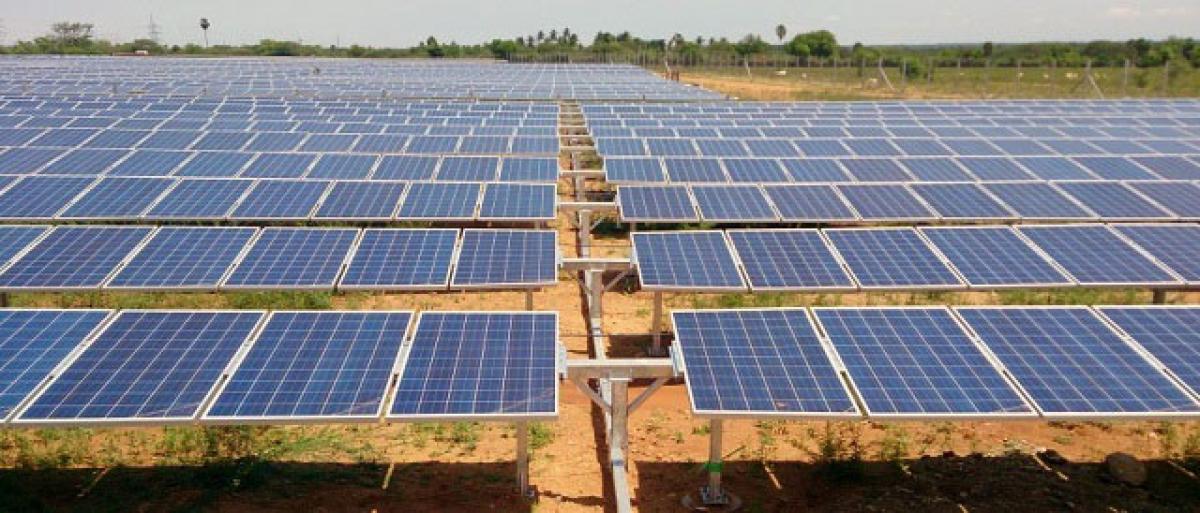Live
- PM Modi highlights govt's efforts to make Odisha prosperous and one of the fastest-growing states
- Hezbollah fires 200 rockets at northern, central Israel, injuring eight
- Allu Arjun's Family Appearance on Unstoppable with NBK Breaks Viewership Records
- Unity of hearts & minds essential for peace & progress, says J&K Lt Governor
- IPL 2025 Auction: I deserve Rs 18 cr price, says Chahal on being acquired by Punjab Kings
- EAM Jaishankar inaugurates new premises of Indian embassy in Rome
- Sailing vessel INSV Tarini embarks on second leg of expedition to New Zealand
- Over 15,000 people affected by rain-related disasters in Sri Lanka
- IPL 2025 Auction: RCB acquire Hazlewood for Rs 12.50 cr; Gujarat Titans bag Prasidh Krishna at Rs 9.5 crore
- Maharashtra result reflects the outcome of Congress' destructive politics: BJP's Shazia Ilmi
Just In

Decentralised solar power, when utilised by unelectrified households, reduces money spent on kerosene but is not conducive to accessing larger social and economic benefits, a study published in Science Advances, an online publication, has found.
Decentralised solar power, when utilised by unelectrified households, reduces money spent on kerosene but is not conducive to accessing larger social and economic benefits, a study published in Science Advances, an online publication, has found.
The study was conducted over a year in 1,281 households from 81 non-electrified rural communities in Suratganj block of Barabanki district, Uttar Pradesh. While half of the population was selected randomly and put into a "treatment" group, which was offered cost-effective solar microgrids by solar service provider Mera Gao Power, the other half, the "control" group, was not given power.
The researchers observed over the period of the study that basic energy access through the micro-grid did not appear to provide broader socio-economic benefits. Installing a solar lighting system had little effect on the household patterns of time spent on work, studying using the light, expenditures, savings or business ownership.
However, after comparing the treatment and control groups, the study found that electrification rates (percentage of households with access to electricity) in the former increased by 29-36 per cent. The electrified households also spent about Rs 47-49 less on black market kerosene per month, while the average spending earlier on black market kerosene was about Rs 73.
"We worked in very small and marginalised communities, even by Uttar Pradesh standards," Michaël Aklin, one of the authors of the paper, told IndiaSpend over email. "For instance, other communities might differ considerably in terms of how wealthy they are or how close they are to the grid. Similarly, if we think about other countries, we would also need to think about the price of kerosene.
The impact of these microgrids could be larger in places in which kerosene is more expensive (which would be the case, for instance, in places without government subsidies)." Around 90 million households still use kerosene for cooking and lighting requirements, according to estimates by the Ministry of New and Renewable Energy (MNRE).
Companies like Mera Gao Power that build small energy grids to power a few households or a village, have the potential to reach 73 million unelectrified households that still use kerosene as their primary source of electricity a polluting source that produces earth-warming carbon dioxide, in addition to emitting gases such as carbon monoxide, nitrogen oxides, and particulate matter, with severe health consequences.
An estimated 1.16 billion people (17 per cent of the world's population) did not have access to electricity in 2015; an estimated 615 million of them are in Asia and the majority of those in India (306 million), according to the International Renewable Energy Agency (IRENA), an inter-governmental organisation that supports transitions to sustainable energy.
For people without access to electricity, off-grid renewable systems, which are cheaper than extending the national grid, are the most economical way to get electricity, according to IRENA. The Jawaharlal Nehru National Solar Mission (JNNSM), one of eight missions initiated to combat climate change through clean energy generation, is a major policy initiative to promote solar energy, including off-grid power development, IRENA said.
India aims to add 2,000 MW off-grid solar applications by 2022 under the JNNSM. This is a part of a larger target to install 175 GW (1 GW is 1000 MW) of renewable generating capacity by 2022, under its commitment to the 2015 Paris Agreement to combat global warming. Off-grid installations will make up a very minuscule part of this target.
Between 2013-17, the mission is expected to deploy around one million solar lighting systems. By March 2017, the government had installed 462.54 MW of solar photovoltaic systems under off-grid applications, according to MNRE. While the government has provided these decentralised power systems for rural electrification since 2001, the sector has seen a surge of private companies recently, according to the Global Network on Energy for Sustainable Development (GNESD).
"The households could use electricity only at night, beginning at sunset and ending by 11 pm," Aklin said. "The main problem is not the number of hours but the amount of power available. The micro-grids we studied only gave people access to mobile charging and two LED lights." (IANS In arrangement with IndiaSpend.org)
By By Mukta Patil

© 2024 Hyderabad Media House Limited/The Hans India. All rights reserved. Powered by hocalwire.com







